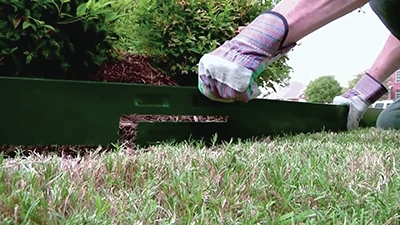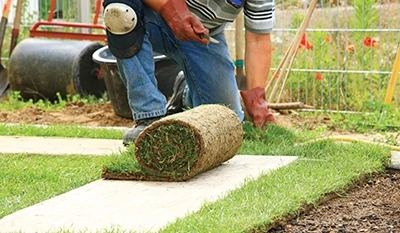Edging Your Lawn to Separate Garden Beds
By Matt Weber
One hallmark of an attractive landscape is the layout of well-defined beds and borders. To form clean lines that separate garden beds and turf, professional landscapers use an edging treatment, which could be made from concrete pavers, natural stone, retaining blocks or continuous strip edging.
Strip edging is the least noticeable option when the aim is to highlight the landscape features rather than the border itself. Strip edging can be used to retain mulch or stone, define a walkway or path, and provide a long-lasting barrier that slows the advance of creeping grasses in the planting area or walkway.
Start by selecting a quality edging product. Avoid using the cheap PVC edging commonly available in hardware stores; it retains its packaged coil shape so it’s difficult to install and it does not last over time. A more durable option is steel landscape edging, which has a thin profile and holds straight lines and curves better. Steel edging will not rot, split, chip or crack and can be repainted periodically. It’s also easy to install and creates a crisp transition line for garden beds that is nearly invisible.
Calculation
The simplest way to calculate the edging materials required for your project is to use a garden hose. Arrange it around the landscape area to plot the line of your edging, using it as a visual guide and adjusting its position until you’re satisfied. Mark the length of the hose you used, stretch it out straight and use a tape measure to determine the required lineal feet.
Refer to the edging product’s installation instructions regarding overlap of the edging strips. For example, the Col-Met edging shown in this article comes in 8-ft. long strips that overlap each other by 8 inches, leaving 7.33 feet of edging. So, for the Col-Met product you would divide the total linear feet for your project by 7.33 feet to determine the number of 8-ft. strips required. For example, 100 divided by 7.33 equals 13.64, so 14 8-ft. edging strips would be required. It’s also a good idea to order a couple of extra pieces in case you decide to change the project during installation.
Excavation
Steel landscape edging varies somewhat in design among manufacturers. In general, the strips are buried in the ground and fastened with anchors or stakes. Always consult the manufacturer’s guidelines for installation procedures that are specific to the edging you’ve chosen.
Before you start, call 811 for utility locations for telephone, gas, water and cable TV. Never assume they are buried deeper than you’ll be digging.

With the Col-Met steel edging shown in this article, you might have soil soft enough that no trenching is required. In this case, simply place the edging on top of the ground where desired, protect the top of the edging with a 2×4 or similar block of wood and, using a 3-lb. mallet, hammer it in to the desired depth.

However, some trenching is usually required, and the best tools for the job are a sharpshooter spade for depth and a half-moon edger for defining the line. Plan ahead if your yard has hard-packed soil. Water the area the night before to soften the dirt and make digging easier.

Digging the trench grants you the ability to form a swale to divide the lawn. Dig down 4 to 6 inches for the edging. On the inside of the edging line (the side with the mulch and planting areas), dig out a 45-degree swale 4 to 6 inches wide from the edging toward the bed. After you anchor the edging into place you should backfill the swale, leaving it a little below ground level on the back side of the edging. This will provide space for mulch, so it doesn’t spill over the edging onto the lawn area.

The swale method also has an additional benefit. By removing the soil and replacing with backfill, the creeping grass that likes to spread into your flower bed has no soil in which to take to take root.

The top of the edging on the lawn side should extend 1/2 to 1 inch above the soil line but not above the grass for a clean look. Don’t leave too much edging protruding above the soil or seasonal changes might heave it out of the ground.


The trenching process for edging is the same for steel, aluminum or PVC edging.


Installation
Always wear safety glasses and work gloves when working with steel edging. The Col-Met strips have stakes attached to the ends of the edging. To install, first pry off the stakes with a pair of Channellock pliers. Place the interlocking ends of one edging strip over the preceding strip, and insert the stakes through the preformed slots to connect the joint. Work along the trench in this manner, fastening each new strip over the last and using four stakes per strip when connecting them end to end. Slip the stakes through the stake pockets just far enough to hold the edging pieces upright and in place.


With a small sledge or heavy hammer, tap all the stakes part way down. Repeat this until all the stakes are flush with the top of the edging and all the strips are driven at least halfway into the ground.


Col-Met’s 14-gauge edging is made from mild carbon steel that you can easily form by hand for contoured shapes, or use a straight board or table edge to bend 90-degree corners with a slight radius.


A hacksaw can be used to cut the edging. Rather than cut from one edge to the other, score the steel edging along its face, then bend it back and forth along the score line until the edging breaks. A powered chop saw will also work.


The top of the edging on the lawn side usually extends 1/2 to 1 inch above the soil line (not above the grass) for a clean look. Remember not to have the edging sticking out of the ground too much. Backfill the swale with stone and/or mulch.


When properly installed, the new steel edging should stay neatly and firmly in place for years to come.
Side Note 1
Throw a Sod Party
When it comes to beautiful garden beds and landscape boundaries, the condition of the lawn on the other side of the edging makes a big difference in overall appearance. Sometimes fertilizing and over-seeding may help, and other times new sod might be the answer.
To install the sod, you’ll see professional landscapers use a tractor fitted with a special sod-laying apparatus hitched to the rear. These attachments are then fitted with large spools of sod (which are backed with mesh). A worker holds one end of the sod strip while the tractor operator pulls forward, literally unrolling the spool of sod in strips. However, the typical DIY approach is to purchase sod in rolls or pallets, have the supplier delver them to the site, and recruit all your friends to help lay it on a weekend.
The sod needs to be installed on your dry soil the day it arrives. If temperatures are above 80 degrees, the soil should be moistened the day before to cool the soil temperatures (but don’t over-water or you’ll be working in mud). Have everyone lay the sod in tightly spaced rows, butted end to end without overlapping. Work on top of plywood sheets to protect the new sod from foot traffic. Use hatchets to cut the sod to fit the property lines and around obstacles in the yard. If you have any gaps, fill with topsoil and add seed.
After the sod is installed the initial watering should soak the sod and hydrate the soil. Keep away foot traffic, and keep the lawn moist at all times, preferably by frequent light sprinklings. The watering process should be repeated three times a day during the hottest months of the year (over 80 degrees) every day. Keep the sod moist to establish root growth but not soaking because too much water can lead to algae and fungus.
Laying sod can be tough work, so make sure to compensate your friends with plenty of pizza and their beverage of choice.
Side Note 2
Hedge Trimming Basics
Some homeowners simply want an orderly, well-manicured row of shrubbery, while others get ambitious and try their hand at forming geometric shapes. For those who keep it simple, stick to the 1/3 Rule when pruning hedges, meaning that you should cut no more than 1/3 the growth at a time. When trimming a hedge to a particular shape, consider the sun’s exposure to the lower branches. The healthiest shape for the plant is a conical one that tapers at the top and allows sunlight to reach all of the branches. Top-heavy shapes, on the other hand, should be avoided because the broad upper branches obscure sunlight from the lower ones. Don’t forget to clip the inner branches to promote healthy growth.
Side Note 3
Stone Edging
Another popular way to create a boundary is to lay a simple border made of interlocking edging stones. Dig the trench as wide as the widest stone with a depth equal to one-half the average height of the stones. Cut the trench with a half-moon edger or spade. Remove the turf to form the trench. Pack the soil remaining in the trench with a hand tamper or a 4×4 block. If the soil drains poorly, then dig the trench 2 inches deeper add base layer of 3/4-minus gravel in the bottom. Lay the edging stones end to end in the trench situated snugly together. Fill the trench with soil up to grade on the grass side of the edging. Pack dirt tightly around the stones to prevent them from shifting. Backfill a flower bed with mulch, or fill with gravel for a walking path. Landscape fabric can help inhibit weed growth inside the bed.









